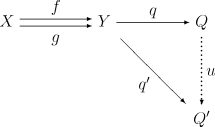Coequalizer
In category theory, a coequalizer (or coequaliser) is a generalization of a quotient by an equivalence relation to objects in an arbitrary category. It is the categorical construction dual to the equalizer (hence the name).
Definition
A coequalizer is a colimit of the diagram consisting of two objects X and Y and two parallel morphisms f, g : X → Y.
More explicitly, a coequalizer can be defined as an object Q together with a morphism q : Y → Q such that q ∘ f = q ∘ g. Moreover, the pair (Q, q) must be universal in the sense that given any other such pair (Q′, q′) there exists a unique morphism u : Q → Q′ for which the following diagram commutes:

As with all universal constructions, a coequalizer, if it exists, is unique up to a unique isomorphism (this is why, by abuse of language, one sometimes speaks of "the" coequalizer of two parallel arrows).
It can be shown that a coequalizer q is an epimorphism in any category.
Examples
- In the category of sets, the coequalizer of two functions f, g : X → Y is the quotient of Y by the smallest equivalence relation
 such that for every
such that for every  , we have
, we have  .[1] In particular, if R is an equivalence relation on a set Y, and r1, r2 are the natural projections (R ⊂ Y × Y) → Y then the coequalizer of r1 and r2 is the quotient set Y/R. (See also: quotient by an equivalence relation.)
.[1] In particular, if R is an equivalence relation on a set Y, and r1, r2 are the natural projections (R ⊂ Y × Y) → Y then the coequalizer of r1 and r2 is the quotient set Y/R. (See also: quotient by an equivalence relation.)
- The coequalizer in the category of groups is very similar. Here if f, g : X → Y are group homomorphisms, their coequalizer is the quotient of Y by the normal closure of the set
- For abelian groups the coequalizer is particularly simple. It is just the factor group Y / im(f – g). (This is the cokernel of the morphism f – g; see the next section).
- In the category of topological spaces, the circle object
 can be viewed as the coequalizer of the two inclusion maps from the standard 0-simplex to the standard 1-simplex.
can be viewed as the coequalizer of the two inclusion maps from the standard 0-simplex to the standard 1-simplex.
- Coequalisers can be large: There are exactly two functors from the category 1 having one object and one identity arrow, to the category 2 with two objects and exactly one non-identity arrow going between them. The coequaliser of these two functors is the monoid of natural numbers under addition, considered as a one-object category. In particular, this shows that while every coequalising arrow is epic, it is not necessarily surjective.
Properties
- Every coequalizer is an epimorphism.
- In a topos, every epimorphism is the coequalizer of its kernel pair.
Special cases
In categories with zero morphisms, one can define a cokernel of a morphism f as the coequalizer of f and the parallel zero morphism.
In preadditive categories it makes sense to add and subtract morphisms (the hom-sets actually form abelian groups). In such categories, one can define the coequalizer of two morphisms f and g as the cokernel of their difference:
- coeq(f, g) = coker(g – f).
A stronger notion is that of an absolute coequalizer, this is a coequalizer that is preserved under all functors.
Formally, an absolute coequalizer of a pair  in a category C is a coequalizer as defined above but with the added property that given any functor
in a category C is a coequalizer as defined above but with the added property that given any functor  F(Q) together with F(q) is the coequalizer of F(f) and F(g) in the category D. Split coequalizers are examples of absolute coequalizers.
F(Q) together with F(q) is the coequalizer of F(f) and F(g) in the category D. Split coequalizers are examples of absolute coequalizers.
See also
Notes
- ↑ Barr, Michael; Wells, Charles (1998). Category theory for computing science (PDF). p. 278. Retrieved 2013-07-25.
References
- Saunders Mac Lane: Categories for the Working Mathematician, Second Edition, 1998.
- Coequalizers - page 65
- Absolute coequalizers - page 149
External links
- Interactive Web page which generates examples of coequalizers in the category of finite sets. Written by Jocelyn Paine.
